SAP Integration:System Configurations
Setting up connections from SAP ERP to SAP Hybris and vice versa. SAP integrations provide a framework for connecting the Omni-commerce capabilities of SAP Hybris Commerce with other SAP products.

According to Hybris, there are 3 possible scenarios of HYBRIS-SAP integration.
1. Asynchronous
2. Synchronous and
3. Hybrid
Asynchronous Integration is through asynchronous communication(IDocs). This method often preferred in B2C and simple B2B scenarios using price lists.
Synchronous Integration is through synchronous communication (RFC). Usually preferred for complex B2B scenarios as well as with clients who heavily invested in backends
Hybrid Integration is through both asynchronous communication(IDocs) and synchronous communication (RFC). Customer interaction happens through Hybris with synchronous calls to SAP ERP.
As you can see, many data point integrations can be either synchronous or asynchronous. These decisions impact everything about our commerce system, from application performance and scalability to customer satisfaction and functionality, so it must be a strategic decision that’s agreed to across all affected parts of the organization.
| Data Point | Synchronous | Asynchronous |
| Product Data | X | |
| Pricing Data | X | X |
| Inventory (Stock) | X | X |
| Customer Data | X | |
| Order Status Data | X | X |
| Order Submission | X | X |
Leveraging real-time, or synchronous, connections require the SAP ERP system to remain responsive to customers at any time they would need access, including nights and weekends, which are typically prime maintenance windows, as well as be able to handle the load caused by exposing ERP data and capabilities to customers.
Data Hub is Hybris preferred approach to asynchronously transfer data from one system into another. To simplify the integration between SAP and Hybris, Hybris has built pre-integrated connectors, allowing the data to flow from SAP directly through the Data Hub and into Hybris. These connectors ease the integration between the systems, specifically for Product Master Data and Customer Master Data. The Data Hub leverages the SAP standard IDOC format to transfer data from SAP into Hybris.
Follow the below step by step procedure for setting up system configurations.
Step 1:
RFC Destination is one of the ways to connect from an ABAP system to an external system.
RFC Destination is defined using the t-code: SM59. Here we are using HTTP connection to the external server (type G) to establish a connection from SAP ERP to SAP Hybris system(for SAP ERP IDoc outbound messages).
Enter the following details and click on Connection test.

Here status 200 shows the connection from SAP ERP to SAP Hybris is successful.

Step 2:
Create an HTTP Connection in SAP ERP for the flow from Hybris DataHub to SAP ERP (for SAP ERP IDoc inbound messages).
Enter the following details and click on Connection test.
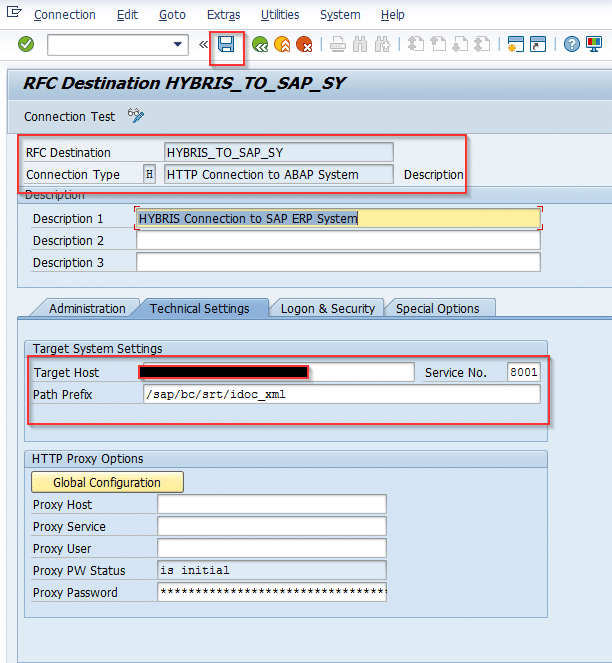
Step 3:
Ports in IDoc Processing. which specifies the way in which the IDocs are transferred from sender to receiver system.
Port is defined using the t-code: WE21. Go to Ports in IDoc processing select the XML HTTP folder in the Ports column and create a Port in SAP ERP for the flow of data from SAP ERP to SAP Hybris.
Enter the following details and click on save.

Step 4:
Go to Ports (t-code: WE21) in IDoc processing select the XML HTTP folder in the Ports column and create a Port in SAP ERP for the flow of data from SAP ERP to SAP Hybris.

Step 5:
A ‘logical system‘ is used to identify an individual client in a system, for ALE communication between SAP systems. Create a Logical System in SAP ERP.
Go to tcode SALE, choose IDoc Interface / Application Link Enabling (ALE)-> Basic Settings -> Logical Systems -> Define Logical System.Click on “New Entries” tab.

Step 6:
Partner Profile is the very important configuration for establishing communication settings between 2 business partners. With whom we are exchanging information, their details maintained in Partner Profile (Partner Number, Partner Type, Partner Function, Message Type, Process Code and Reciever port)
Go to t-code WE20, Select partner type LS(logical system) and enter the below details.

To create outbound parameters, click on create new outbound parameters and we will enter different message types we need one by one. Click on save and back button.
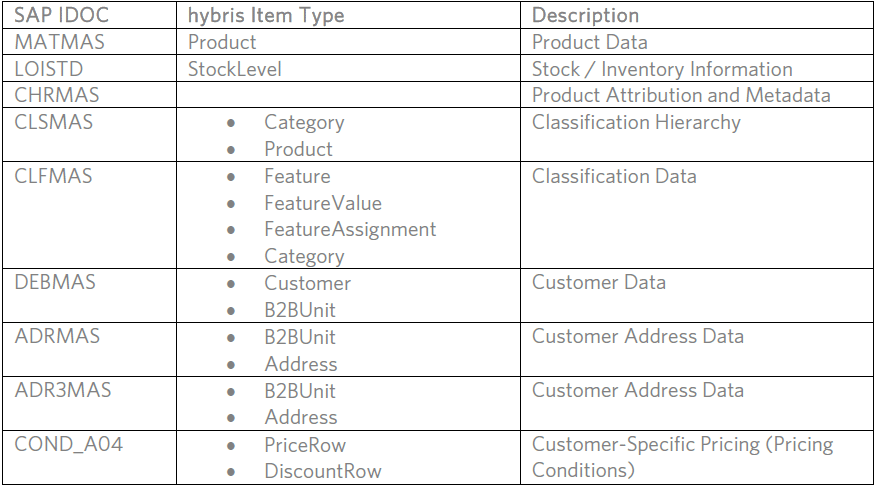

To create inbound parameters, click on create new inbound parameters and enter different message type we need and Click on save button.
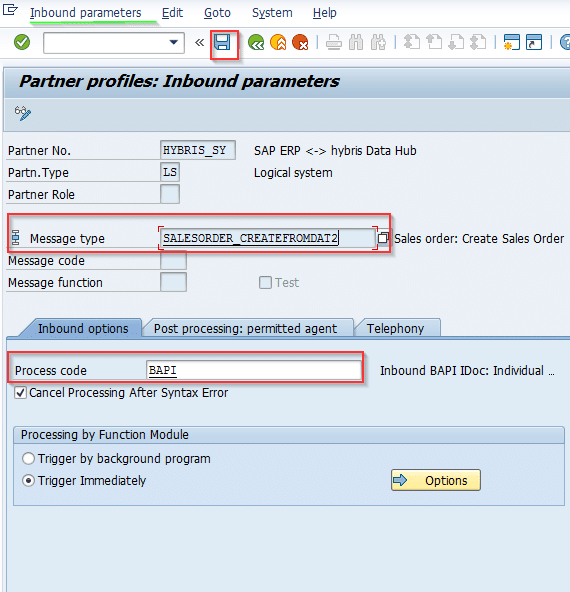
Finally, It will be as follows once we click on the back button.

Step 7:
Create an HTTP Destination in Hybris Management Console (HMC) for the flow from SAP Hybris to SAP ERP (for SAP ERP IDoc inbound messages).

URL: https://xyz.net:8001/sap/bc/srt/idoc?sap-client=800
Give Basic Authentication details (user id and password) and click on save.

Step 8:
Create a SAP Global configurations.Go to HMC->SAP Integration->SAP Global configurations->Back-End Connectivity.
Enter the above-created HTTP destination and click on Save.

Step 9:
Create an RFC Destination in HMC, for the flow from Hybris DataHub to SAP ERP, required for Synchronous Pricing retrieval.Go to HMC->SAP Integration->RFC Destination>

Enter the below details and click on Logon tab.

Give Basic Authentication details (user id and password) and click on save.

Now click on Ping Destination.We will get a pop-up screen with Connection is successful.

Step 10:
Create a SAP Base Store Configuration , assigned above RFC destination.Go to HMC -> SAP Integration -> SAP Base Store Configuration – > Create SAP Base Store Configuration.
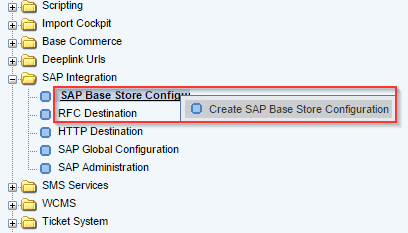
Click RFC Destination search option, it opens the popup with the list of RFC, we need to select one (click on use).and then click on save.
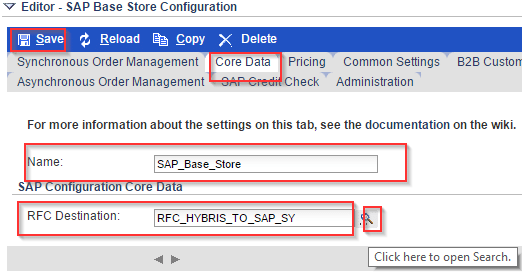
Step 11:
Synchronize Common Data between SAP ERP and SAP Hybris.In SAP ERP, Go to SE38 t-code.
ZCUSTOMIZING_AS_IMPEX_VER6_1, it is reference by installing SAP note 1983231. We need to execute the file and show the path where the file need to download and select the multiple languages (EN & DE).

Customizing.impex file will be automatically downloaded to the path specified once we click on execute button.

Step 12:
Go to HMC->user->titles and delete all the titles.

Step 13:
Go to Hybris Administration Console(HAC) -> Impex Import -> click on import file

Once the Impex import successfully then titles (HMC->user->titles) will come based on the Impex file which we are uploading.
Thanks for reading ????
New NetWeaver Information at SAP.com
Very Helpfull
